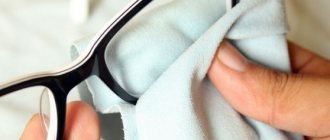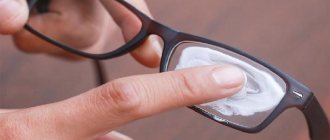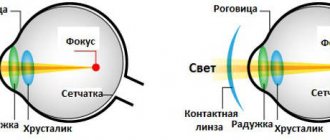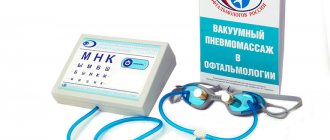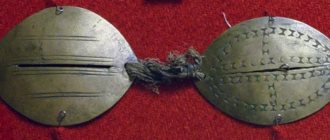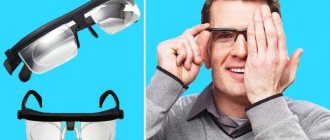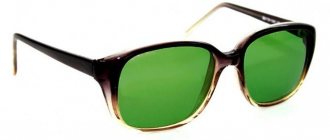Glasses are one of the main ways to correct farsightedness today.
Most often they are prescribed to children. The fact is that farsightedness is absolutely normal for a child. As the eyeballs develop, this feature disappears in babies. However, to prevent the child from feeling discomfort, the doctor will often write a prescription for glasses. In almost 100% of cases, by the age of 10, or at least by the age of 15, the child’s vision is completely corrected.
Also, quite often, ophthalmologists recommend wearing glasses for people after 40 years of age who begin to develop presbyopia (age-related farsightedness).
The main task facing ophthalmologists is the competent selection of glasses. In order for the farsighted eye to see everything clearly, it is important to choose the right lenses, frames, their material and shape. Incorrectly chosen glasses can not only distort the surrounding objects, but also cause headaches, nausea, dizziness and eye fatigue.
Do you need glasses?
Farsightedness is an eye disease in which the focus of vision is behind the retina. The patient believes that he sees only objects located far away, but this is incorrect. Distance vision during illness is also not healthy, however, it is better than near. Some people refuse glasses until the last moment, but this is the only universal way to maintain visual balance without surgical or laser intervention. Glasses for farsightedness are a mandatory attribute for the patient. It is prohibited to select optics yourself. Only an ophthalmologist can prescribe treatment and choose glasses for distance.
When farsightedness is the result of age-related changes, doctors offer products with 2-3 diopters. At the same time, at the age of 60 years and older there is no need to constantly change them, since changes in the lens no longer occur. For those who were previously nearsighted, their vision may improve by this age, making glasses no longer necessary.
Which ones to pay attention to?
The choice of lens depends on the stage of the disease.
Medicine distinguishes 3 main stages of disease development:
- weak degree - up to 3 D;
- average - 3-6 D;
- heavy - 6+D.
Based on vision indicators, the general condition of the body and individual characteristics, glasses for vision with farsightedness are selected. There are several types of optics:
- Progressive view - distinguished by the presence of specific lenses.
- Trifocal - glass divided into three zones: near focus, intermediate vision and far distance.
- Bifocal - two-zone: focusing far and close.
- For looking into the distance - for mild cases.
- For a close-up view, it is recommended for severe forms of the disease.
- Correction of hypermetropia (farsightedness) is performed with lenses, which are indicated by a “+” sign.
How to choose?
The doctor will select different glasses for work and for everyday life.
Choosing optics is not always easy. Doctors advise taking into account several important details. Some of them:
- Patient's profession. How far vision needs to be fixed depends on the specifics of the patient’s work. The standard is 20-30 centimeters, but this distance must be changed if the patient’s type of activity requires it. For example, the distance for a driver is 70 cm, and for a musician it is a meter. The exact indicators are determined solely by the doctor. But the fact is clear: the glasses should be weak in these cases.
- The lens-eye distance is 12 mm. Even a slight deviation from the norm deforms the lens and changes the angle of view, which will cause discomfort in the future.
- The glass must be positive. The correct ones are selected individually.
- Doctors recommend different options for spectacle correction for different types of work.
- Eliminates frame discomfort.
Causes of age-related farsightedness
Normally, in healthy people, a beam of light passes through the pupil, is refracted in the cornea and lens, and is projected onto the retina. It is then that the impulse is correctly deciphered by the brain, and the person clearly sees the surrounding objects.
The main refractive element is the lens. It bends depending on the near or far location of objects. To do this, he needs accommodative muscles. Over time, the quality of metabolism in the muscles decreases and the regenerative function of cells decreases.
Additionally, insoluble protein fractions accumulate in the lens, which reduce its transparency. This is why there is a decrease in visual acuity for near objects. Eyeballs begin to age along with a person.
Recommendations for using glasses
To ensure that using optics is not accompanied by discomfort, it is important to choose the right glasses. The rules are as follows:
- Getting used to the lenses takes an average of 2 weeks. If after this period the discomfort becomes stronger, you should consult a doctor.
- If you have hypermetropia, optics should be worn regularly without taking them off.
- Purchasing a cover will be useful as it will prevent premature damage to the glass.
- To wipe, you need a small piece of soft cloth.
- You cannot choose lenses for farsightedness on your own without the advice of a doctor.
- For monotonous work that requires extreme precision, for example, knitting or reading, glasses with LED backlight are selected.
Can I wear it all the time?
The use of optical devices should not cause discomfort in the eyes.
A person who encounters glasses for the first time will feel severe inconvenience. The average time to get used to glasses is 2 weeks. If no improvement is observed during this time, then it’s time to see the doctor again. Ophthalmologists recommend keeping glasses on after adjustment in case of eye disease, especially presbyopia or “senile vision.” If glasses are a necessary age requirement (45 or older), they do not need to be worn regularly, or used combined for myopia and farsightedness. The form of the disease changes regularly, so regular examinations are essential.
The disease also occurs in children, so complaints of poor vision or severe pain in the eyes should not be ignored. It is important to contact a specialist as soon as possible to diagnose the problem. For farsightedness in a child, the only effective treatment is the use of glasses.
The choice of glasses depending on the degree of pathology
With a low degree of hyperopia, a person sees objects poorly only at a close distance from him. At the same time, he can easily read signs and make out license plates. In this case, the ophthalmologist writes a prescription for glasses that should not be used all the time, but only when reading books, newspapers or magazines, while working at the computer, when writing letters or performing work that requires attention to the smallest details. After examining the patient, the doctor writes a prescription for lenses with the appropriate dioptric values (+).- With a higher degree of farsightedness, the results of a number of examinations indicate that hypermetropia causes defocusing of objects not only at close range, but also at a distance from the person (at least at arm's length). In this case, the doctor must recommend glasses to the patient that he will use and wear constantly. They will help relieve tension from the oculomotor muscles and relax them. They can also relieve the patient from asthenopic complaints: headaches, burning, discomfort in the visual organs.
Flaws
Farsighted people need to use glasses, but the products have negative sides - discomfort on the bridge of the nose, regular contamination, falls. The main drawback is that even strong optics are not able to provide perfect vision correction. Glasses worn constantly limit the possibility of lateral vision and cause severe headaches. On the other hand, it is impossible to ignore doctors’ recommendations on the use of optics; vision will deteriorate, this leads to an irreversible process. Such changes also apply to the wrong choice of glass or frame. If the patient does not feel relief within 2 weeks, the glasses most likely require replacement.
For minor work, an ophthalmologist may prescribe light-up glasses. The wrong choice of glasses is accompanied by severe headaches, fatigue and decreased performance. It is not recommended to wear the same glasses for more than one year. Vision regularly changes due to various circumstances, and therefore requires correction and new approaches to treatment.
Different glasses options
One of the most common and, unfortunately, unsafe mistakes when farsightedness increases with age is choosing glasses on your own. The man philosophically declares: “It’s just my time has come...” - and goes to the nearest “Optics” to choose more or less suitable glasses for himself, not considering it necessary to visit an ophthalmologist first. The risk of such self-diagnosis is that vision deterioration may not be a consequence of age, but simply a coincidence with it; the real cause of farsightedness in an elderly person often has nothing to do with age-related tissue changes. In this case, precious time is wasted, the pathology quickly progresses, and the patient comes to the doctor with a full-blown and advanced disease, which would be much easier to prevent in the earliest stages. In addition, glasses with inadequate optical parameters for this particular case - and it must be said that the correct selection of glasses is by no means as simple as it seems to many - can cause direct harm to the eyes instead of optical correction. Finally, a number of anamnestic features should be taken into account: the state of vision in childhood, the presence of previously diagnosed refractive errors (myopia, astigmatism), concomitant somatic and/or endocrine diseases and many other factors.
In any case, when transitioning from reading with the naked eye to wearing plus glasses, you should first monitor and record new sensations: is there a headache, are your eyes tired, is there heaviness in the brow ridges or bridge of the nose, is there a feeling of pressure , bloating, pain or other discomfort. If you experience any of these symptoms, you should see a qualified ophthalmologist immediately.
How does the eye see with farsightedness?
All refractive errors are characterized by one thing - incorrect refraction of rays reflected from objects around us, including people. When starting a conversation about the structure of the eye or touching on it in the article, we have already talked more than once about the structure of the light-refracting and light-conducting apparatus of the eye. Let's remember once again what it consists of.
So, the light-refracting and light-conducting apparatus of the eye includes:
- cornea; - lens; — moisture of the anterior and posterior chambers of the eye; - vitreous body.
The cornea is the front shell of the eye, which is also the very first refractive medium, its refractive power is 50%, it is the strongest refractive structure of the eye. We know that normally the eye has a spherical shape, and accordingly the structures of the eye, especially the cornea, will have a corresponding structure, then round. This is normal. The refraction of the rays will be correct and they will be focused at one point on the retina, as shown in the figure below.
With farsightedness, the eye has a more flattened shape, or, to put it another way, it is more elongated along the vertical axis. In this case, the refraction of the rays will be insufficient, that is, weak, this will lead to the fact that the light rays will be focused behind the retina, see the figure below.
You may be interested in Green glasses for glaucoma
This eye structure is an individual characteristic, genetically determined, and manifests itself with age. But, here it is worth making a reservation and this is important. In children under one year of age, slight hypermetropia is normal; this is a feature of the structure of the eyes at this age. This usually goes away by the age of 8-9 years, the child’s vision becomes normal and after an examination by an ophthalmologist, a diagnosis is made – emmetropia, that is, normal.
If, upon reaching the age of 8-9 years, hyperopia persists or the indicators of farsightedness are higher than the age norm, perhaps in this case we will be talking about congenital hyperopia, which will not go away on its own as the child grows older. In the future, vision correction will be required either with glasses or contact lenses. Unfortunately, it will not be possible to correct vision using laser eye surgery, since the child is under 18 years old; this is a mandatory age limit; sometimes persons under 21 years of age are not allowed to undergo the operation, but this is individual. The age limit is due to immaturity, that is, not complete formation of the eyeball. In the period up to 18-21 years, it continues to grow and only by these years does it reach its physiological size.

